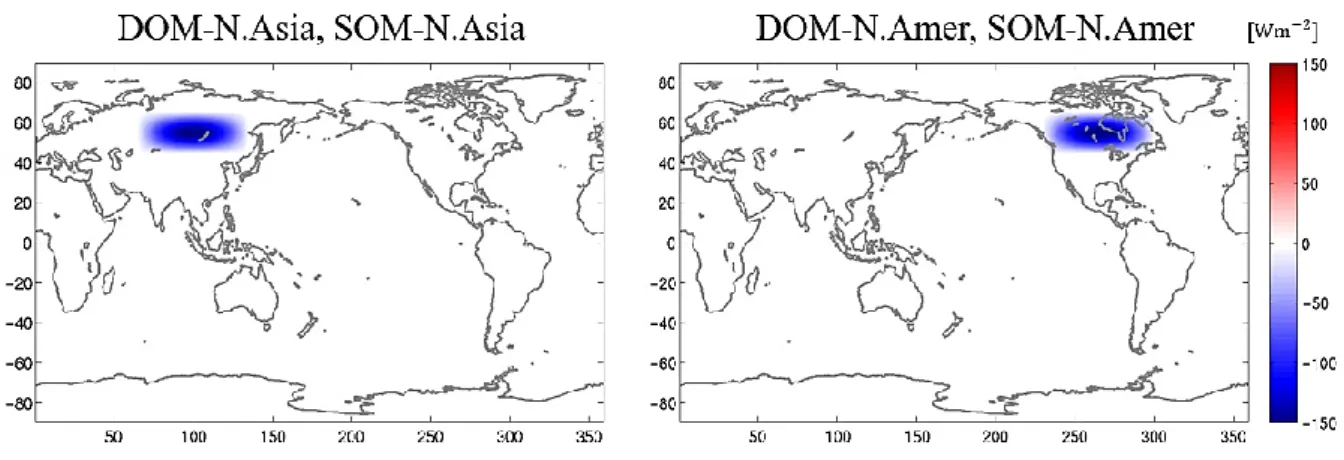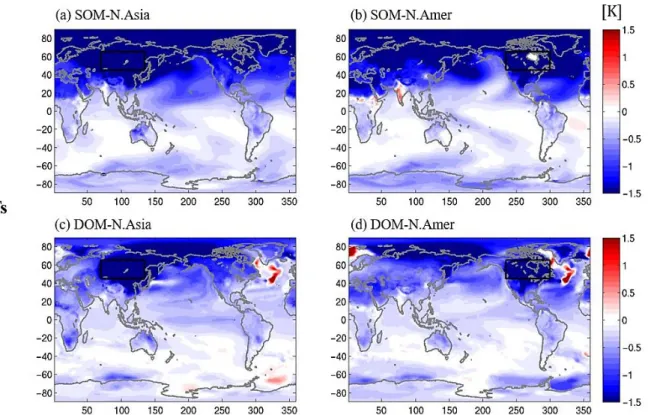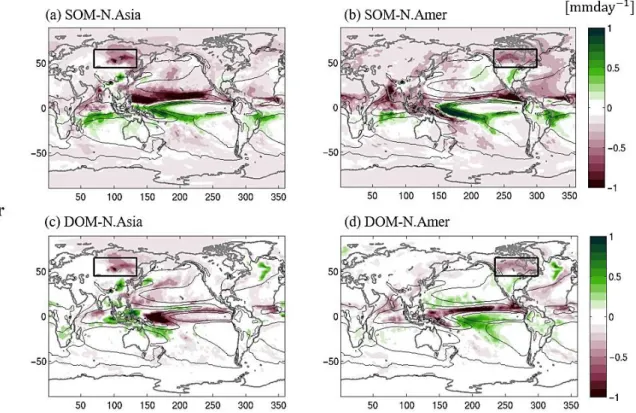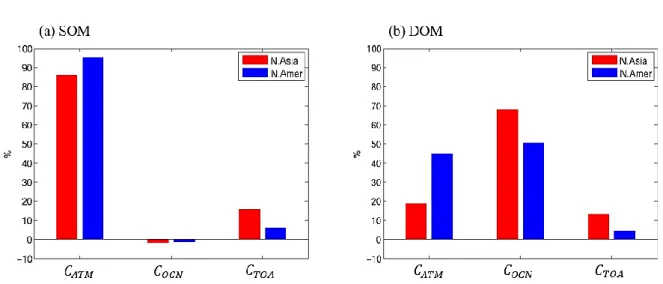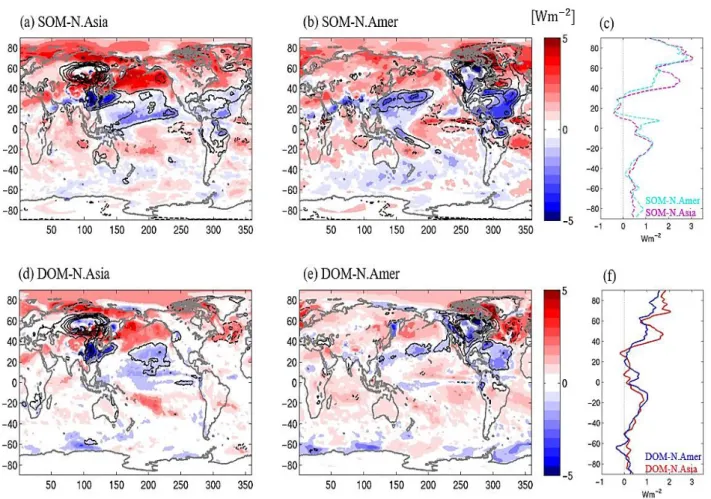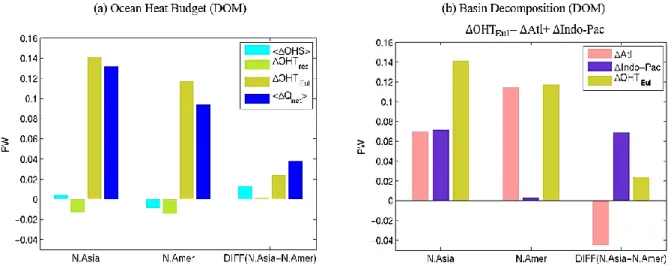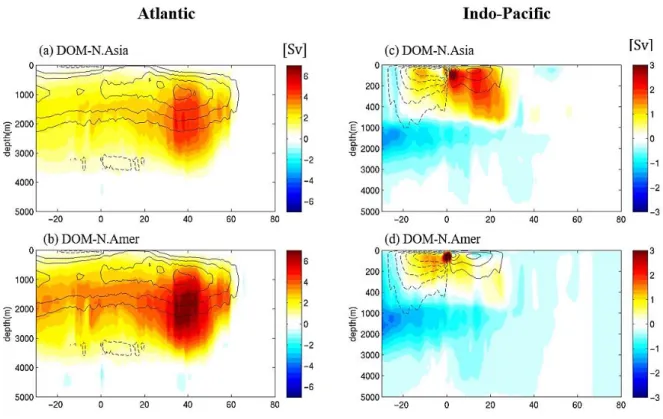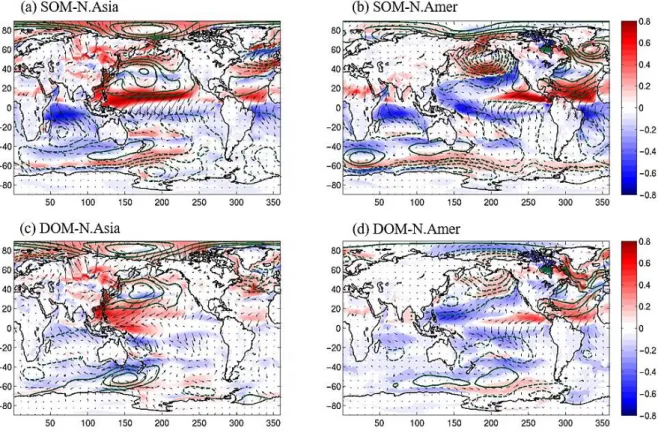The plate-ocean model produces similar patterns of tropical climate responses that are almost insensitive to the longitudinal forcing location. A strengthening of the Atlantic Meridional Overturning Circulation after an imposed North American cooling effectively brings the heat and explains most of the ocean heat transport response. However, Pacific trade winds tend to weaken in response to anomalous low pressure over the North Pacific, and therefore the influence of heat transport in the Indo-Pacific is very small.
Cooling in North Asia makes a similar contribution to ocean heat transport in both the Atlantic and Indo-Pacific Oceans. High-pressure anomaly over the North Pacific causes a strengthening of the Pacific equatorial trade winds, the northward Ekman transport, and the Northern Hemisphere subtropical cell. The response of annual mean global surface temperature for (a) SOM-N.Asia, (b) SOM-N.Amer, (c) DOM-N.Asia, and (d) DOM-N.Amer.
Global mean annual precipitation response (shade) for (a) SOM-N.Asia, (b) SOM-N.Amer, (c) DOM-N.Asia, and (d) DOM-N.Amer. Partial compensation (%) by atmospheric heat transport (𝐶𝐴𝑇𝑀), ocean heat uptake (𝐶𝑂𝐶𝑁) and TOA radiation (𝐶𝑇𝑂𝐴) averaged between 5 OM (D.B) and OM (a. b) MOC in DOM-CTRL (interval contour = 5 Sv) in (a, b) Atlantic Ocean and (c, d) Indo-Pacific Ocean.
Composite annual mean anomalies of surface winds and sea level pressure for (a) SOM-N.Asia, (b) SOM-N.Amer, (c) DOM-N.Asia, and (d) DOM-N.Amer.
Introduction
Unlike the results, dynamical ocean studies note that the change of tropical precipitation depends largely on the detail, including the location and shape of disturbance (Westervelt et al. 2018; White et al. 2018). In particular, the changes in ocean circulation are efficient in transporting heat to the cooler hemisphere through wind-driven shallow overturning circulations (Schneider 2017; Green and Marshall 2017;. We focus in particular on the extent of zonal-mean tropical climate response, the distribution of the energy transport between atmosphere and ocean, and the effectiveness of different ocean circulation components.
We also examine the spatial pattern of tropical climate response, and the differences between the plate-ocean model and the fully coupled model, which can distinguish the impact of the dynamic ocean. Therefore, we study the dependence of the tropical climate response on the longitude of extratropical disturbance.
Methods
Data, Model and Experiments
In idealized experiments of previous studies, high-latitude forcing was found to be most effective for moving the ITCZ (Seo et al. 2014). In addition, the propagation of regional disturbances along the climatological westerly wind can be expected to significantly affect the adjacent oceans, the Pacific and Atlantic basins. The Pacific is dominated by wind-driven subtropical cells (STCs) and the Ekman Current, while the thermohaline circulation is key in the Atlantic.
Thus, we observe that the different characteristics of the ocean dynamics in the two oceans have different impacts on the tropical climate responses. All perturbed experiments are integrated for 100 years and annual averages for the last 70 years are analyzed to avoid the initial transient period. Although 100 years is not enough time for the deep ocean circulation to overturn to reach a steady state, this study period provides guidance on possible changes from localized disturbances and allows comparison with previous studies (e.g., Kang et al. . 2018).
Since the actual global mean radiative forcing due to anthropogenic sulfate is measured at -0.5 to -1.5 Wm2, we concentrate this radiative forcing in each localized region. Given the same magnitude of the perturbation by directly reducing the solar constant, we can compare the difference between the perturbations for the same condition.
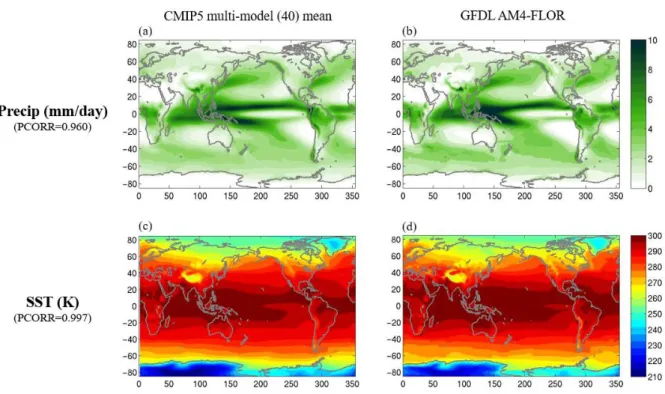
Analysis Methods
We define the three compensations as the fraction of the effective forcing balanced by the radiative changes of AHT, OHU, and TOA, as The ocean is a quasi-equilibrium state during our averaging periods, then the change in OHS cannot be zero and is calculated directly as,. The meridional OHT is separated into four components (Liu et al. 2018; Yang et al. 2015): Eulerian mean circulation, bolus circulation (mesoscale eddies), submesoscale circulation (driven by mixed layer eddies), and diffusion.
Here we consider a residual term (OHTres) including the bolus, sub-mesoscale circulation and diffusion, because the magnitude of the components is relatively much weaker in the tropics. The Euler mean ocean MOC is calculated by integrating the Euler mean meridional velocity (𝑣̅) multiplied by the water density (𝜌) zonally and vertically:
Results
- Responses of surface temperature and precipitation
- Atmospheric energy budget and TOA radiation response
- Ocean heat budget and MOC response
- Coupling of the atmosphere and ocean circulations
In particular, the change of tropical Pacific rainfall pattern in DOM-N.Amer still shows southward shift, but in DOM-N.Asia there is an equatorially symmetric pattern of tropical precipitation that decreases over the tropical Pacific and increases over the oceanic continent . From the SOM simulations, Δ𝑅𝑇𝑂𝐴 tends to show a downward radiative bias above the 30°N and upward radiative bias in the northern subtropics (10-30°N) in both experiments (Fig. 3.2.2a-c). Conversely, increased OLR in the northern subtropics is due to the decrease in high cloud amount responding to the ITCZ shift.
In other words, in the SOM the positive feedback in the northern subtropics partially cancels negative feedback at mid-high latitudes, resulting in similar compensation by TOA radiation as DOM. ΔOHTres acts in the opposite direction to 〈∆𝑄𝑛𝑒𝑡〉 and is not considered to determine the experimental difference of 〈∆𝑄𝑛𝑒𝑡〉 because both experiments have similar values of about -0.01 PW. The ∆OHT in the Atlantic Ocean is strongly linked to AMOC, which can also be seen in the mass transport streamfunction anomalies shown in Figure 3.3.2a,b.
In both experiments, the AMOC is strengthened for extratropical cooling of the NH, and AMOC strengthening leads to a reduced meridional SST gradient in the NH. The strong strength of the AMOC in DOM-N.Amer is associated with a forcing domain very close to the AMOC subduction zone. The climatological westerly wind at these latitudes induces the advection of cold into the extratropical forcing and then induces a stronger SST cooling response in the North Atlantic Ocean.
The STCs are important for the transport of energy with the poleward flow at the sea surface, subsidence in the subtropics, equatorward return and upwelling in the tropics. The strengthening of the NH STC in DOM-N.Asia is a major contributor in determining the difference in 𝐶𝑂𝐶𝑁 between the two experiments, with an amount similar to the energy transported by AMOC. The reason for the STC change can be found in the change in pressure on the extratropical forcing and the resulting wind response (Fig. 3.4.1).
In this experiment, the anomalous cooling (Q < 0) is balanced by poleward meridional motion (v > 0), leading to warm advection in the NH. These pressure patterns are remarkably similar between the SOM and DOM, and then the resulting wind responses are comparable to the pattern except in the equatorial Pacific. High pressure over the North Pacific in DOM-N.Asia causes an increasing easterly wind response in the tropical and subtropical North Pacific Ocean (Figure 3.4.1c).
In DOM-N.Amer, on the contrary, the Pacific trade winds tend to weaken in response to the low pressure system (Fig. 3.4.1d), hence the influence of Indo-Pacific OHT is very small (Fig. 3.3 .1b, 3.3.2d). In addition, the easterly wind anomaly in DOM-N.Asia is enhanced by equatorial upwelling in the eastern Pacific and a Bjerknes positive feedback (Bjerknes 1969) with a La Nina-like cooling pattern as shown in Figure 3.1.1c.
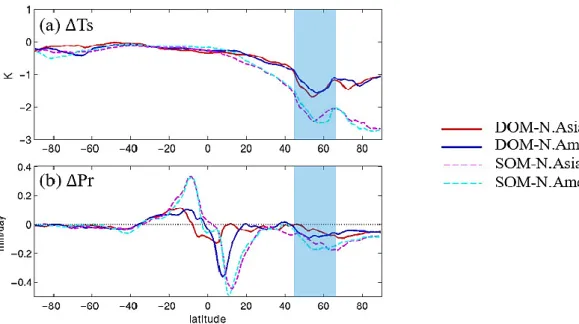
Conclusion and Discussion
Global emissions of anthropogenic aerosols peaked in the 1970s over the USA and Europe, and their aerosol emissions are decreasing due to clean air regulations (Klimont et al. In contrast, the contribution of Asia has been increasing rapidly in the last few decades (Klimont et al. We will also extend this study and propose a decomposition of the mean and difference between North Asia and North America and a comparison between the mean and the course of zonally uniform pressure in ETIN-MIP (Kang et al. 2019).
It would be informative to find out what produces the observed historical pattern of La Nina-like SST in the equatorial Pacific to different radiative forcings. The role of ocean–atmosphere coupling in the zonal-mean atmospheric response to Arctic sea ice loss. Influence of the extratropical ocean circulation on the intertropical convergence zone in an idealized coupled general circulation model.
Southern Ocean albedo, interhemispheric energy transports, and the dual ITCZ: Global impacts of biases in a coupled model. Anthropogenic sulfate aerosol and the southward shift of tropical rainfall in the late 20th century. Response of the ITCZ to extratropical thermal forcing: Idealized plate-ocean experiments with a GCM.
Global climate impacts of adjusting the Southern Ocean shortwave radiation bias in the Community Earth System Model (CESM). Winter aerosol chemistry and smog evolution in a heavily polluted city of the North China Plain: significant contribution from coal and biomass burning. Natural and anthropogenic climate change: including historical land cover change, vegetation dynamics and the global carbon cycle.
Two hundred and fifty years of aerosols and climate: the end of the aerosol era. Fast and slow shifts of the zonal-mean intertropical convergence zone in response to an idealized anthropogenic aerosol. Contrasting effects of radiation in the Southern Ocean versus the Southern Tropics on the position of the ITCZ and energy transport in one GFDL.
